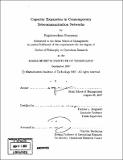| dc.contributor.advisor | Thomas L. Magnanti. | en_US |
| dc.contributor.author | Sivaraman, Raghavendran | en_US |
| dc.contributor.other | Massachusetts Institute of Technology. Operations Research Center. | en_US |
| dc.date.accessioned | 2008-09-03T15:09:05Z | |
| dc.date.available | 2008-09-03T15:09:05Z | |
| dc.date.copyright | 2007 | en_US |
| dc.date.issued | 2007 | en_US |
| dc.identifier.uri | http://hdl.handle.net/1721.1/42273 | |
| dc.description | Thesis (Ph. D.)--Massachusetts Institute of Technology, Sloan School of Management, Operations Research Center, 2007. | en_US |
| dc.description | Includes bibliographical references (p. 155-160). | en_US |
| dc.description.abstract | We study three capacity expansion problems in contemporary long distance telecommunication networks. The first two problems, motivated by a major long distance provider, address capacity expansion in national hybrid long distance telecommunication networks that use both the traditional TDM technology and more recent VoIP technology to transport voice calls. While network capacity expansion in general is known to be hard to approximate, we exploit the unique requirements associated with hybrid networks to develop compact models and algorithms with strong performance guarantees for these problems. For a single period single facility capacity expansion problem in a hybrid network, using a decomposition approach we design a (2 + E)-factor approximation algorithm. Generalizing this idea, we propose a Decentralized Routing Scheme that can be used to design approximation algorithms for many variations of hybrid network capacity expansion. For the Survivable Capacity Expansion Problem in hybrid networks, in which we are required to install enough capacity to be able to support all demands even if a single link fails, we propose a compact integer program model. We show that this problem is APX-Hard, and present two heuristics with constant worst case performance guarantees. Finally, we consider the capacity planning problem when peak demands occurring at different times can share network capacity. We propose a general model for capturing time variation of demand, and establish a necessary and sufficient condition for a capacity plan to be feasible. Using a cutting plane approach, we develop a heuristic procedure. Computational experiments on real and random instances show that the proposed procedure performs well, producing solutions within 12% of optimality on average for the instances tested. The tests also highlight the significant savings potential that might be obtained by capacity planning with time sharing. | en_US |
| dc.description.statementofresponsibility | by Raghavendran Sivaraman. | en_US |
| dc.format.extent | 160 p. | en_US |
| dc.language.iso | eng | en_US |
| dc.publisher | Massachusetts Institute of Technology | en_US |
| dc.rights | M.I.T. theses are protected by
copyright. They may be viewed from this source for any purpose, but
reproduction or distribution in any format is prohibited without written
permission. See provided URL for inquiries about permission. | en_US |
| dc.rights.uri | http://dspace.mit.edu/handle/1721.1/7582 | en_US |
| dc.subject | Operations Research Center. | en_US |
| dc.title | Capacity expansion in contemporary telecommunication networks | en_US |
| dc.type | Thesis | en_US |
| dc.description.degree | Ph.D. | en_US |
| dc.contributor.department | Massachusetts Institute of Technology. Operations Research Center | |
| dc.contributor.department | Sloan School of Management | |
| dc.identifier.oclc | 231845664 | en_US |
